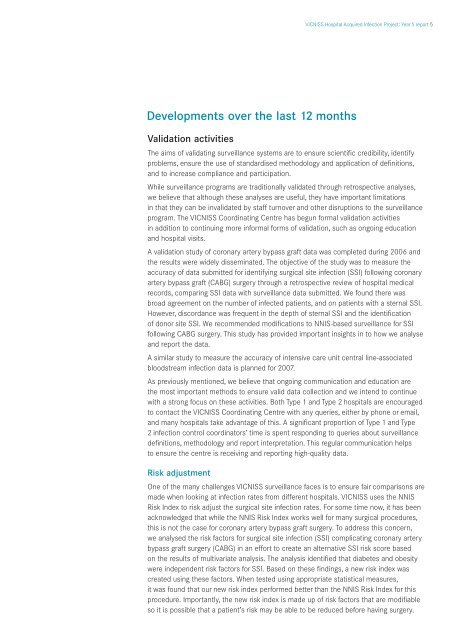VICNISS - Hospital Acquired Infection Project - Department of Health
VICNISS - Hospital Acquired Infection Project - Department of Health
VICNISS - Hospital Acquired Infection Project - Department of Health
You also want an ePaper? Increase the reach of your titles
YUMPU automatically turns print PDFs into web optimized ePapers that Google loves.
<strong>VICNISS</strong> <strong>Hospital</strong> <strong>Acquired</strong> <strong>Infection</strong> <strong>Project</strong>: Year 5 report 5<br />
Developments over the last 12 months<br />
Validation activities<br />
The aims <strong>of</strong> validating surveillance systems are to ensure scientific credibility, identify<br />
problems, ensure the use <strong>of</strong> standardised methodology and application <strong>of</strong> definitions,<br />
and to increase compliance and participation.<br />
While surveillance programs are traditionally validated through retrospective analyses,<br />
we believe that although these analyses are useful, they have important limitations<br />
in that they can be invalidated by staff turnover and other disruptions to the surveillance<br />
program. The <strong>VICNISS</strong> Coordinating Centre has begun formal validation activities<br />
in addition to continuing more informal forms <strong>of</strong> validation, such as ongoing education<br />
and hospital visits.<br />
A validation study <strong>of</strong> coronary artery bypass graft data was completed during 2006 and<br />
the results were widely disseminated. The objective <strong>of</strong> the study was to measure the<br />
accuracy <strong>of</strong> data submitted for identifying surgical site infection (SSI) following coronary<br />
artery bypass graft (CABG) surgery through a retrospective review <strong>of</strong> hospital medical<br />
records, comparing SSI data with surveillance data submitted. We found there was<br />
broad agreement on the number <strong>of</strong> infected patients, and on patients with a sternal SSI.<br />
However, discordance was frequent in the depth <strong>of</strong> sternal SSI and the identification<br />
<strong>of</strong> donor site SSI. We recommended modifications to NNIS-based surveillance for SSI<br />
following CABG surgery. This study has provided important insights in to how we analyse<br />
and report the data.<br />
A similar study to measure the accuracy <strong>of</strong> intensive care unit central line-associated<br />
bloodstream infection data is planned for 2007.<br />
As previously mentioned, we believe that ongoing communication and education are<br />
the most important methods to ensure valid data collection and we intend to continue<br />
with a strong focus on these activities. Both Type 1 and Type 2 hospitals are encouraged<br />
to contact the <strong>VICNISS</strong> Coordinating Centre with any queries, either by phone or email,<br />
and many hospitals take advantage <strong>of</strong> this. A significant proportion <strong>of</strong> Type 1 and Type<br />
2 infection control coordinators’ time is spent responding to queries about surveillance<br />
definitions, methodology and report interpretation. This regular communication helps<br />
to ensure the centre is receiving and reporting high-quality data.<br />
Risk adjustment<br />
One <strong>of</strong> the many challenges <strong>VICNISS</strong> surveillance faces is to ensure fair comparisons are<br />
made when looking at infection rates from different hospitals. <strong>VICNISS</strong> uses the NNIS<br />
Risk Index to risk adjust the surgical site infection rates. For some time now, it has been<br />
acknowledged that while the NNIS Risk Index works well for many surgical procedures,<br />
this is not the case for coronary artery bypass graft surgery. To address this concern,<br />
we analysed the risk factors for surgical site infection (SSI) complicating coronary artery<br />
bypass graft surgery (CABG) in an effort to create an alternative SSI risk score based<br />
on the results <strong>of</strong> multivariate analysis. The analysis identified that diabetes and obesity<br />
were independent risk factors for SSI. Based on these findings, a new risk index was<br />
created using these factors. When tested using appropriate statistical measures,<br />
it was found that our new risk index performed better than the NNIS Risk Index for this<br />
procedure. Importantly, the new risk index is made up <strong>of</strong> risk factors that are modifiable<br />
so it is possible that a patient’s risk may be able to be reduced before having surgery.

















